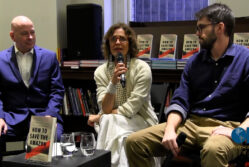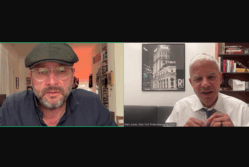Archive Event Highlight

Washington Post Photographer Salwan Georges Recounts Return to Iraq after Two Decades
by Chad Bouchard
When Washington Post staff photographer Salwan Georges fled Iraq with his family in 1998 at the age of 8, he did not expect he would be away from those he left behind for more than two decades, and did not expect conditions to be worse, in many ways, than they were before the war.
“[Under U.S. sanctions before the war] we had no fresh milk, so we had to use powdered milk. There was barely any electricity, only maybe two or three hours a day. It wasn’t a livable country. So we fled to Syria and took refuge there. Then after five years, we made it to Detroit,” Georges said during a program with Post colleagues on March 16.
The discussion, part of the OPC’s “How I Did It” series on exceptional feats of journalism, centered on a personal photography project Georges started working on many years ago to document his own story and that of his family in the U.S., as family members they left behind suffered violence, including some who were killed in the war. He started by using the camera of an early model of iPhone, which helped him capture candid images “and to be more natural around relatives.”
That project is what drove him to pursue photography, which eventually led to his position at the Post. Recently, he returned to Iraq for the first time since leaving 25 years ago to finish the project by documenting how his homeland had changed.
“When I got to Iraq, it all hit me. I finally felt that it’s a place I belong.”
Olivier Laurent, a senior photo editor on the Post’s foreign desk, served as moderator. He displayed images from Georges’ project including some from his recent homecoming. He asked Georges about his first impressions of Iraq in 2023.
“Seeing my old home, my school, the neighborhoods where I grew up, it was an amazing feeling to finally have that kind of closure, to reconnect with my roots,” he said.
However, Georges found that years of violent conflict had changed the country dramatically. “I almost don’t recognize it. It has almost doubled in population. Life is harder on Iraqis right now. Now there is electricity, but it’s from generators. And those generators are polluting the air to the extent that my colleagues had to use [respirators] to be able to breathe there,” he said. “I can only imagine what a kid growing up in Iraq right now would feel, to think this is normal, to live and go to school in this kind of polluted environment.”
Salwan’s colleague Louisa Loveluck, the Post’s Baghdad bureau chief who has been covering the region for 10 years, joined the discussion.
She said now, despite a political crisis over the last three years that led to a new government and Prime Minister last year, where Iraqis “really for the first time tried to take their future in their own hands,” the country still faces extremely difficult challenges.
“There isn’t open violence on the streets so there should be space for progress, space for people to start living a dignified life, and that is what hasn’t happened, because of the way the political system has developed.”
After the 2003 invasion, Loveluck said, U.S. promises of peace and prosperity from regime change were not realized, as the policy of so-called de-Ba’athification decimated the state by removing the country’s most experienced civil leaders and leaving a “lost generation” in its wake.
“In the years that followed, what has replaced what was taken is fundamentally, incredibly corrupt,” she said. “Public institutions have been gutted. It’s hard to get a job without a bribe. It’s a pretty dire situation for [young people] even if, as you see in these photos, there’s not really any violence in the streets.”
She added that the promise of democracy was never delivered, and from Saddam Hussein to U.S. occupation, to sectarian militias, to ISIS, there had never really been choice and self-determination in Iraq. Youth protests against corruption in 2019 spread from Baghdad to southern parts of the country, defying sectarian categories that had been imposed on them from outside.
“The biggest division in society at this stage is the elite against the people, particularly the youth. And they sang and they danced and they called for the overthrow of the entire system, really posing something of an existential challenge against a system that was incredibly strong.”
She said the ensuing crackdown against protesters was more violent than anything she’d seen elsewhere in the Middle East for a country that is not at war.
“Protesters were kidnapped nearly every day, they had stun grenades fired literally into their heads. It was remarkably violent and by the end over 600 people were killed, 20,000 people were wounded. This generation that had tried so hard to say ‘no, this is our time. We want our future,’ – a lot of them realized the political system that grew up with them was stronger and ultimately prevailed.”
Georges said he experienced many mixed emotions when he returned. As he watched colleagues such as Loveluck covering news in his homeland and risking their lives to report on developments, he felt a calling to return and try to help. He struggled with painful feelings when he visited such places as the grave of his grandfather, only to see that it had been destroyed by soldiers as they searched for illegal weapons, or when he visited the site where is uncle was killed by a car bomb while working as a translator for the U.S. military.
But Georges also said he was struck by an overwhelming sense of being at home.
“It’s hard to describe it unless you live through it. Being there, being able to walk down the street and communicate with people, no matter where I was coming from,” he said. “The [Iraqi] love of life never changed, was always there. And when I got there and was around my friends and my colleagues, it really made me feel that as hard as they tried to take that away from us, Iraqis were still standing. And people stayed who they are.”
Georges said he hopes to turn the photography project into a book in the future.
Click the window below to watch video clips from the program, or click here for a link to the playlist on YouTube.



